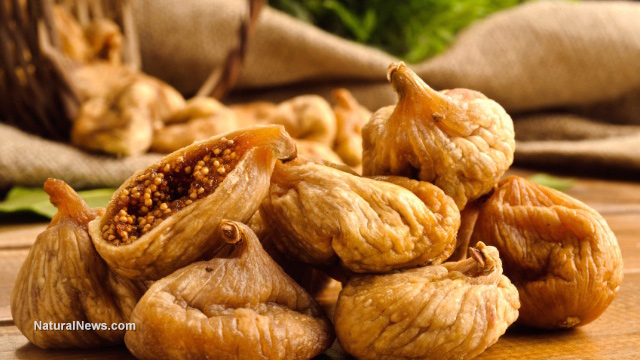
Figs are good for relieving constipation, lowering cholesterol, lowering blood pressure, weight loss, preventing osteoporosis and heart disease, promoting tanning, and they are a good source of prebiotics. Figs are high in calcium, potassium, phosphorus, and iron.
Natural remedies and prevention with figs
Figs are high in fiber and are therefore an excellent laxative, so good in fact, you have to be careful not to eat too many. They are also a good source of prebiotics, which provide support for the gut's good bacteria.
Figs and fig juice are highly alkaline and therefore can help balance the body's pH levels, and they are full of antioxidants that help prevent damage from free radicals. They are also a good source of psoralens, a compound that is used to treat skin disorders such as psoriasis, eczema, and vitiligo.
Due to their high potassium content, figs are believed to be useful in prevention of high blood pressure and heart disease. Their combination of potassium and calcium help prevent osteoporosis.
Figs have long been believed to be both an aphrodisiac and a means to aid in male sexual stamina and enjoyment.
Tree sap from the fig tree is used to treat ringworm, warts, insect bites and skin irritations.
Raw or cooked
Figs are picked ripe from the tree. Due to the fact that dried figs are so popular and are available year round, many of us have never tasted a raw fig. Raw figs are quite delicious, though unusual in both texture and taste. The taste of a raw fig is milder, more subtle, than dried figs or cooked figs.
Both raw and dried figs are often used in baking. Figs add moistness and extend freshness in baked goods.
Dried figs can be eaten plain, used for cooking/baking baking in dry form or used for cooking by being reconstituted into a paste or pudding.
Fruit agriculture
Although figs originate on the other side of the Atlantic, we don't have to worry about their carbon footprint. The U.S. is ranked 3rd in the world for production of dried figs with an annual volume of 11,000 tons, and California grows 98% of the fresh figs sold in the U.S.
There are many varieties of figs and several commercial varieties.
Organic vs. conventional figs
Figs, both raw and dried, can be found organic or conventional.
Things you didn't know about figs
You know how tomatoes aren't vegetables; they are scientifically classified as a fruit? Well, figs aren't really a fruit, but they aren't a vegetable, either. They are actually the flower of the plant, while their seeds are technically the fruit.
Figs are one of the oldest known cultivated foods.
How to store figs so they last longer
Figs are picked ripe and have a very short shelf life. Most sites say they will last 2-3 days, but they may last 5-7 if very fresh. Do not wash them until use. Bag them and refrigerate. You can also bag them and freeze them for up to 6 months.
Dried figs should be stored in a cool, dry place or in the refrigerator. Their shelf life is 6 months.
How to Pick Good Fruits
Choose clean, sweet-smelling, fruit that yields to a light touch. Do not buy mushy or split fruit. Scarring on the skin is okay; scars are the result of leaves brushing against the skin.
http://www.naturalnews.com/046872_figs_potassium_fiber.html

No comments:
Post a Comment